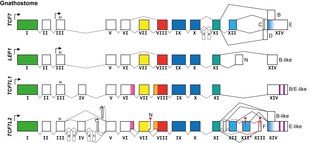Related Research Articles
Chromatin is a complex of DNA and protein found in eukaryotic cells. The primary function is to package long DNA molecules into more compact, denser structures. This prevents the strands from becoming tangled and also plays important roles in reinforcing the DNA during cell division, preventing DNA damage, and regulating gene expression and DNA replication. During mitosis and meiosis, chromatin facilitates proper segregation of the chromosomes in anaphase; the characteristic shapes of chromosomes visible during this stage are the result of DNA being coiled into highly condensed chromatin.

DNA-binding proteins are proteins that have DNA-binding domains and thus have a specific or general affinity for single- or double-stranded DNA. Sequence-specific DNA-binding proteins generally interact with the major groove of B-DNA, because it exposes more functional groups that identify a base pair.
HMGN proteins are members of the broader class of high mobility group (HMG) chromosomal proteins that are involved in regulation of transcription, replication, recombination, and DNA repair.
SOX genes encode a family of transcription factors that bind to the minor groove in DNA, and belong to a super-family of genes characterized by a homologous sequence called the HMG-box. This HMG box is a DNA binding domain that is highly conserved throughout eukaryotic species. Homologues have been identified in insects, nematodes, amphibians, reptiles, birds and a range of mammals. However, HMG boxes can be very diverse in nature, with only a few amino acids being conserved between species.
HMGA is a family of high mobility group proteins characterized by an AT-hook. They code for a "small, nonhistone, chromatin-associated protein that has no intrinsic transcriptional activity but can modulate transcription by altering the chromatin architecture". Mammals have two orthologs: HMGA1 and HMGA2.

High-mobility group AT-hook 2, also known as HMGA2, is a protein that, in humans, is encoded by the HMGA2 gene.

High mobility group box 1 protein, also known as high-mobility group protein 1 (HMG-1) and amphoterin, is a protein that in humans is encoded by the HMGB1 gene.

High-mobility group protein HMG-I/HMG-Y is a protein that in humans is encoded by the HMGA1 gene.

Lymphoid enhancer-binding factor 1 (LEF1) is a protein that in humans is encoded by the LEF1 gene. It is a member of T cell factor/lymphoid enhancer factor (TCF/LEF) family.

DNA damage-binding protein 2 is a protein that in humans is encoded by the DDB2 gene.

High-mobility group protein B2 also known as high-mobility group protein 2 (HMG-2) is a protein that in humans is encoded by the HMGB2 gene.

Non-histone chromosomal protein HMG-14 is a protein that in humans is encoded by the HMGN1 gene.

Thymocyte selection-associated high mobility group box protein TOX is a protein that in humans is encoded by the TOX gene. TOX drives T-cell exhaustion and plays a role in innate lymphoid cell development.
TOX high mobility group box family member 2, also known as TOX2, is a human gene.
TOX high mobility group box family member 3, also known as TOX3, is a human gene.

In molecular biology, the HMG-box is a protein domain which is involved in DNA binding. The domain is composed of approximately 75 amino acid residues that collectively mediate the DNA-binding of chromatin-associated high-mobility group proteins. HMG-boxes are present in many transcription factors and chromatin-remodeling complexes, where they can mediate non-sequence or sequence-specific DNA binding.

The AT-hook is a DNA-binding motif present in many proteins, including the high mobility group (HMG) proteins, DNA-binding proteins from plants and hBRG1 protein, a central ATPase of the human switching/sucrose non-fermenting (SWI/SNF) remodeling complex.

The TCF/LEF family is a group of genes that encode transcription factors which bind to DNA through a SOX-like high mobility group domain. They are involved in the Wnt signaling pathway, particularly during embryonic and stem-cell development, but also had been found to play a role in cancer and diabetes. TCF/LEF factors recruit the coactivator beta-catenin to enhancer elements of genes they target. They can also recruit members of the Groucho family of corepressors.
High mobility group protein HMG14 and HMG17 also known as nucleosomal binding domain is a family of evolutionarily related proteins.

High mobility group nucleosome-binding domain-containing protein 4 is a transcription factor that in humans is encoded by the HMGN4 gene.
References
- ↑ Rajeswari MR, Jain A (2002). "High-mobility-group chromosomal proteins, HMGA1 as potential tumour markers" (PDF). Current Science. 82 (7): 838–844.
- ↑ Johns EB (1982). The HMG chromosomal proteins. Boston: Academic Press. ISBN 978-0-12-386050-7.
- ↑ Sitia G, Iannacone M, Müller S, Bianchi ME, Guidotti LG (January 2007). "Treatment with HMGB1 inhibitors diminishes CTL-induced liver disease in HBV transgenic mice". J. Leukoc. Biol. 81 (1): 100–7. doi: 10.1189/jlb.0306173 . PMID 16935945.
- ↑ Murugesapillai, Divakaran; McCauley, Micah J.; Huo, Ran; Nelson Holte, Molly H.; Stepanyants, Armen; Maher, L. James; Israeloff, Nathan E.; Williams, Mark C. (2014). "DNA bridging and looping by HMO1 provides a mechanism for stabilizing nucleosome-free chromatin". Nucleic Acids Research. 42 (14): 8996–9004. doi:10.1093/nar/gku635. PMC 4132745 . PMID 25063301.
- ↑ Murugesapillai, Divakaran; McCauley, Micah J.; Maher, L. James; Williams, Mark C. (2017). "Single-molecule studies of high-mobility group B architectural DNA bending proteins". Biophysical Reviews. 9 (1): 17–40. doi:10.1007/s12551-016-0236-4. PMC 5331113 . PMID 28303166.
- ↑ Reeves R. High mobility group (HMG) proteins: Modulators of chromatin structure and DNA repair in mammalian cells. DNA Repair (Amst). 2015 Dec;36:122-136. doi: 10.1016/j.dnarep.2015.09.015. Epub 2015 Sep 16. PMID 26411874